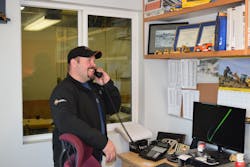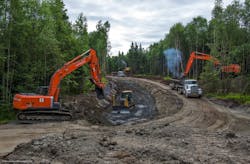Recruiting qualified heavy equipment employees in an industry where talent pools have almost dried up is a major challenge for every fleet manager in the private or public sector.
This persistent problem was created by what might be called an occupational evolution: Many of the best and brightest have heeded the sirens’ call to pursue careers in other industries that out-glitter wrench-
turning and dirt-moving.
Reprinted with the permission of Equipment Manager magazine, the magazine of the Association of Equipment Management Professionals.
One way to hurdle the issue is to grow your own shop crop. Dakota County (Minn.) has a mixed fleet of 687 active units. That includes heavy equipment, trailers, attachments, trucks, pickups, sedans, law enforcement vehicles, and push mowers. Keeping that fleet physically fit and available for operation is accomplished by only a baker’s dozen of fleet employees.
Equipment manager Kevin Schlangen, CEM, CPFP, CAFM, explains a recruitment method that has worked well for him.
“It’s a rough industry right now in identifying qualified technicians, so we work closely with the human resources department to make sure our job descriptions are up to date and our pay equity is close to what is paid in the private sector.
“Understand that in government, as a general rule, we have a difficult time because of the pay-scale difference, and also we can’t move as fast on making changes when we’re trying to hire.”
To circumvent the pay scale difference, Schlangen, whose team was named a 2017 Fleet Master, “works hard with the HR department to emphasize other benefits that we offer as a government agency that contractors can’t.”
Training is important, as it is in the private sector, so Dakota County has made ASE (Automotive Service Excellence) part of its minimum qualifications for a job. Employees are tested constantly on different levels of the program. “As an ASE Blue Seal shop, we keep up with all levels of that area,” says Schlangen.
Dakota County also covers training expenses and gives its shop crew time to attend trade shows, expos, and different training events, he says.
Another factor that helps attract and keep good workers, Schlangen says, is the county’s facilities themselves.
“Ours is quite a bit nicer than some I’ve seen,” he says. “I have worked outside government before, so I know how good I’ve got it here as far as facilities are concerned.”
In addition, Schlangen says, generally government shop employees have better working conditions and hours than in construction with job sites spread all over. “We work basically Monday through Friday hours, except for emergency situations, such as a heavy snow event.”
With a contractor, Schlangen says, you can work seven days a week with 14-hour days. “The money is great. However, not only does it wear you down physically, it is really difficult for your family.”
Dakota County also provides technicians with tools that many times are better than the ones employees own. “The tools come with the job so, yes, we may not pay as much per hour, but our technicians can keep all their tools at home. This enables them to work outside jobs, if they want to, and still have a full-time job here. We also supply all uniforms, clothing, and all the testing equipment.”
Schlangen describes himself as “pretty damn picky” when it comes to recruiting. One reason is that, unlike in the private fleet sector, “in government, you can’t up and fire someone who isn’t doing the job,” he says.
“We have different responsibilities and criteria from the private sector. We have to be very specific on our questioning, our interviews, and our background checks. Right now, all our positions are filled—but recruiting qualified workers has been so difficult that it’s been nearly three years since we have been fully staffed.”
Many of the good hires have come from local colleges, and one of his sources is a college less than two miles from his shop. “I got to know a number of instructors up there, and because of that we started attending their job fairs, in addition to high school job fairs. We set up our little booth and tell them what we have to offer.”
Because Schlangen’s budget has a line item that lets him hire part-time temporary employees, he tries to hire a person from the colleges for six months. While they attend school, he hires them part time. During school breaks, he will have them work full-time hours. Out of the three people he hired last year, two of them had been students and trainees in his shop prior to being hired.
In Alaska, the same acute need exists for workers. Anchorage-based Davis Constructors & Engineers/Mass Excavation are two different companies, says Craig Worrell, CEM, equipment manager of both organizations. Mass Excavation “does the dirt side, such as utilities and underground work, and Davis Constructors & Engineers builds the new buildings,” he says. The combined fleet of both companies totals about 500 units.
Worrell is a member of the 2015 class of Under 40 in Construction Equipment. Nominations now being accepted for the next class.
Recruitment for each company differs. On the Davis Constructors side, for instance, recruitment targets would be product managers and engineers. Mass Excavation recruits technicians, oilers, and shop hands.
Since Worrell’s shop is union, union halls are a source for recruitment. “When there are not enough people or qualified hands in the hall, there is some flexibility… that allows us to bring on qualified guys and put them in the union so they can work on our jobs,” he says.
HR posts available positions on the company’s own website, and he uses online postings. “That’s where we start. We don’t go outside the Internet, and we don’t use recruiting services,” Worrell says.
Although some other fleet professionals make use of social media, Worrell rarely does. “I will tell somebody to send me a text message or email, but generally that’s as far as I go,” he says. “Social media such as Facebook or Twitter can provide a lot of exposure, but not necessarily the kind you want. I prefer methods that will target the people with the skills I need in the shop.”
Because the number of qualified people “is inadequate in construction, particularly in the 35-to-50 age bracket, it is not unusual for some competitors to steal experienced people from another shop or maybe from a dealer,” he says. “We don’t do that. Whatever free agents, you might say, are running around out there, are few.”
Worrell says he has never taken anyone from dealers he works with. “We have a good relationship with our dealers and an understanding that I won’t do it to them and they won’t do it to me. There is also a lot of time and training involved in developing a good workforce. There is also a lot of mutual respect between us that goes into dealer relationships too.”
When a position does come open in his shop, Worrell writes a job description and gives it to the HR department. They put it into a format for the public, and the opening is posted on the company’s website, Craigslist, and other online sites. The HR department scans the responses and sends them to Worrell for review.
“I put them in separate groups, based on the candidate’s experience and potential,” he says. “There might be Group 1, who are the first pick; Group 2, the second pick; and Group 3, the third.
“We don’t use professional services to do background checks,” he says. “If you see a large gap in an individual’s work background, most of the time that means they were in trouble. Also, driving records are very important to us. We don’t want someone with a bad driving record operating our trucks or machines.”
After the screening, telephone calls go out to two or three likely candidates, who come in for face-to-face interviews. If a candidate is called in for a second interview, that’s when a job offer is made. The entire process takes about a month.
By being involved with AEMP and current events in the other departments, Worrell can keep up with other developments relative to the fleet operation, such as what laws are new that affect the construction industry. In fact, legislation was passed last year legalizing marijuana in Alaska.
“I think that could create a lot of problems,” he says. “Our company, however, requires you to pass a drug test with the paperwork from the screen.”
But the most important guideline of all is not on the résumé, he says. Pay attention to the individual’s attitude.
“I would take a person with a good attitude and less experience and develop them,” he says, “over a negative person who can be cancerous. It only takes one person to poison the well, and if you get four or five going around with bad attitudes, you’re going to have a real problem.”

